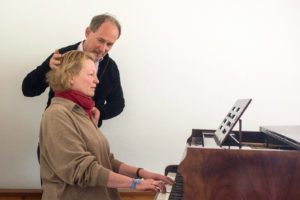
Unique to this method is Peter Grunwald’s discovery, that every single area of the visual system corresponds with an associated area in the body. Specific vision malfunctions such as short and farsightedness, astigmatism, middle aged vision (presbyopia), squints and lack of binocular vision, as well as glaucoma or cataracts are linked to specific tensions and contractions in the body.
Peter Grunwald talks about the beginnings of the Eyebody Patterns:
“I first discovered a very real association between my eyes and the rest of my body back in 1992. Sitting in my teaching room in Auckland, New Zealand, I was reflecting on my life-long astigmatism. I knew that astigmatism is partly due to abnormal curvatures of various meridians of the cornea. As I sat pondering I thought of shortening and narrowing the cornea. (Such mental techniques were familiar to me from my Alexander Technique background, but only as far as the body was concerned, never the eyes.) Immediately I noticed marked slumping in my upper chest. With a sense of surprise, and being careful not to lengthen my body stature but to direct my cornea to lengthen and widen, I noticed that my chest was moving up. I repeated the same thought process and to my astonishment it happened again. Over and over.
 Excited but cautious, I asked some of my students later in the day to apply their thinking to their corneas… and the same thing happened for every one of them. By the end of the day I thought: if there is a certain relationship between the chest and cornea, I wonder what other associations there are between the eyes and body?
Excited but cautious, I asked some of my students later in the day to apply their thinking to their corneas… and the same thing happened for every one of them. By the end of the day I thought: if there is a certain relationship between the chest and cornea, I wonder what other associations there are between the eyes and body?
Over the following weeks, months and years I discovered more and more associations. I became aware of an emerging pattern. Mapping the eye and the body I found the entire torso within the eyeball from the neck to the pelvis. To date, I have discovered the precise correlations between many specific areas of the body and the visual system – more areas are being added all the time as they reveal themselves.
For example with shortsightedness (myopia) there is a contracting of the visceral organs (vitreous humor), shortening of the lumbar region (retina), which affects the pelvis, the head of femur (blind spot) and the femur bone (optic nerve) as well as the patella (lateral geniculate body) and the feet (visual cortex). Further postural aspects show a shortening of the brainstem and spinal cord, which causes the head to move back and down, shortening the entire body structure (torso corresponds to the eyeball). This affects the bone structure of the eye-socket in general, with the tilting forwards and down of the sphenoid bone, where the optic nerve (upper leg) crosses from the brain to the eyeball (lower part of the body to the torso).”



